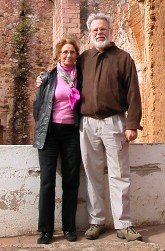While waiting for things to get started on the house, I began doing a chain of title. The people at the records office looked at me like I was nuts when I kept going back and back for more records. One actually refused to get me more information, claiming it had been lost. She apparently did not think what I was doing was appropriate behavior. I finally got the document from another employee. The Notary Public when we bought the house only went back to the late 1940s, one of the reasons I wanted to do a real chain of title.
In 3 or 4 hours, I was able to get it back to the 1940s in the current property records; and then had to get a special permit to work in the historic archives. This meant a copy of my passport and two passport-like photos and meeting with the head archivist. Fortunately, we had some photos left over from our visa registration in June.
Working in the historic archives was a different process. Not only did I have to buy and use a face mask and surgical gloves (for my protection presumably), but rather than looking things up by date and time (you find the date and time of the previous sale in the record of the current sale), you need to know the name of the Notary Public who oversaw the transaction. All the historic records are organized by Notary Public. These are the actual records that the Notary Public maintained and that have now been donated to the archives. They are written in longhand in large ledgers with tax stamps and annotations as the property later changed hands. They are not all complete or indexed, so it is a challenge. I now have our house back to 1919, with a reference to a purchase in 1899. Problem is that in 1919 various properties were transferred in an inheritance, and the normal rule of following the Notary Public may not apply as there is no reference to a Notary Public for our house, although there is for another property in the inheritance.
Little things creep out in the property transactions including the fact that women often had men sign for them since they could not write (and it is apparent that some of the signatures in the records are from people who did not often sign their names), that people were selling property to their tenants and family members, that the then current addresses of the purchaser and seller were usually listed, that the property in the 1930s starts being referred to as a farm which probably means they used the back of the property where the kitchen and back garden were to grow stuff for sale, and that the price of the house often stayed the same from one purchaser to another for a decade running, or that it even lowered in price.
The neighbors are, with one exception, the same now as they were in 1919, and that exception was the sister of one of the other owners. This is, of course, patently impossible unless we have three people in our neighborhood who must be aged 110+, and I know the neighbor to the south has only owned it for about 10 years. There are usually references to people’s nationality (always Mexican), age, marital status, and sometimes occupation. One of my favorite occupations was “dedicada a las labores proprias de su sexo”, the woman was “dedicated to the labors proper to her sex”, i.e. a housewife, and that was in 1945. Sounds like south Georgia of the 1970s. Neither the husband nor the wife could write and “signed” the papers with their fingerprints.
If I can get past the 1919 transfer, I hope to get the chain back to the time the house was first built so I can figure out who might have had the fresco painted and when.
Subscribe to:
Post Comments (Atom)

1 comment:
Archivists can be a pain sometimes... :) Thanks for all the updates to the blog. It's not exactly like being there, but at least I feel like I know what's going on!
Post a Comment